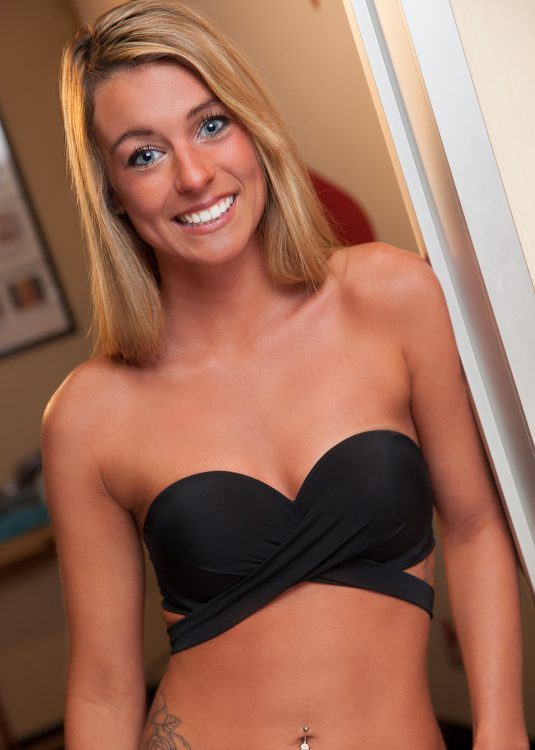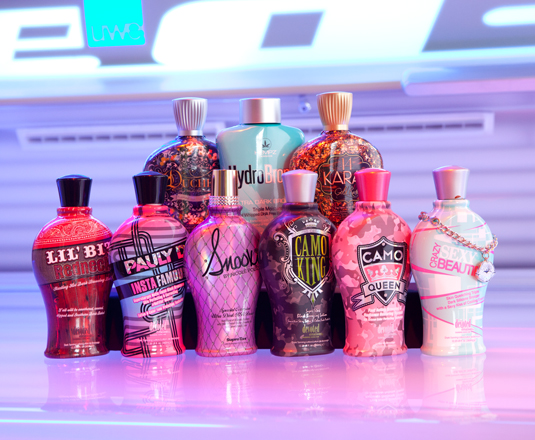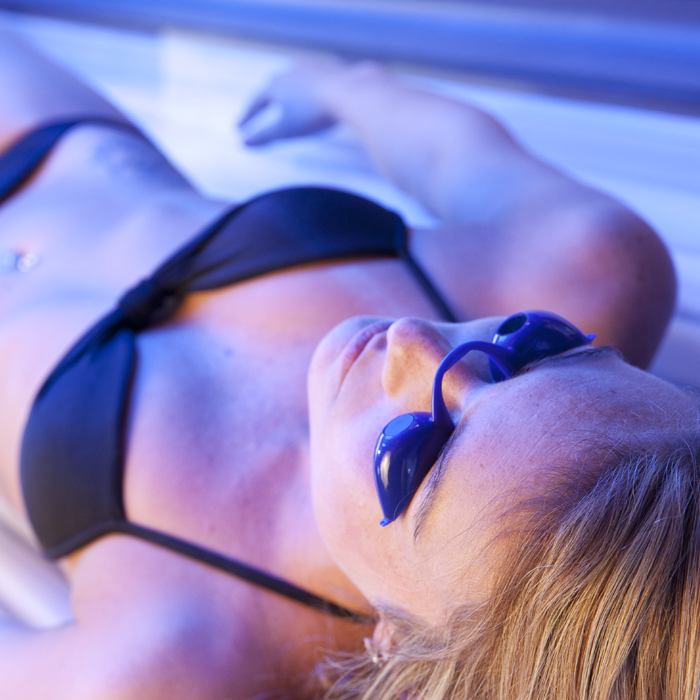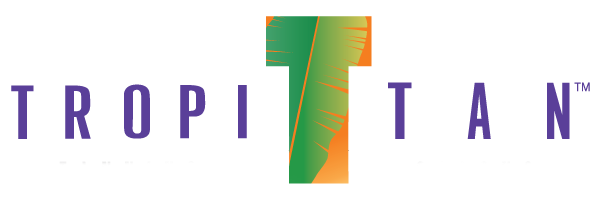
Welcome to Tanning 101

A Tropi Tan Tan is a Healthy-Looking Tan!
Our Tanning Consultants are trained to help you achieve a tan that looks good, and that you’ll feel good about. By following our exposure schedules, you can develop a great tan without burning. If you have any questions or concerns about your progress, please don’t hesitate to ask.
Here are some tips for getting better results and protecting your skin’s health during the tanning process:
- Moisture is the key to a healthy-looking tan! Tanning lotions prepare your skin for UV exposure and reduce the drying effects of the tanning process. They also contain ingredients that promote the production of melanin in your skin, and special vitamins that keep your skin healthy. Tropi Tan Tanning Salons offer a variety of lotions and moisturizers specifically designed for indoor tanners at every level.
- If you plan to tan in the nude, you should expose sensitive areas of your body gradually during your tanning sessions to avoid sunburn.
- Your lips produce very little melanin and are prone to UV-overexposure, so you should always protect them with a sunscreen. SPF lip balms are available at all Tropi Tan Tanning Salons.
- Many products we all use every day – such as make-up and perfumes – contain ingredients that can make your skin more susceptible to sunburn (photosensitive). Common prescription drugs and over-the-counter medications can also cause photosensitizing reactions. Our Tanning Consultants have a list of such substances for your review.
FAQs
How do we get a tan?
The tanning process is really quite simple, and works the same way whether you tan indoors or outdoors. Ultraviolet light is the catalyst, and a pigment produced by your skin called melanin does the rest.
Here’s a basic explanation of the tanning process:
- Tanning occurs in the skin’s outermost layer, the epidermis. About five percent of the cells in your epidermis are special cells, called melanocytes. Everyone has the same number of melanocytes in their body – about five million. Your heredity dictates your skin type, and how much melanin your body will produce.
- When exposed to ultraviolet B light (short-wave UV), the melanocytes produce melanin – the pigment that is ultimately responsible for your tan. The pinkish melanin travels up through the epidermis and is absorbed by other skin cells. When exposed to ultraviolet A light (longer-wave UV), the melanin oxidizes or darkens. This darkening of your skin – your tan – is its natural way of protecting itself against UV overexposure.
- A sunburn, or erythema, is the result of UV-overexposure – when too much UV light reaches the skin and disrupts the tiny blood vessels near the surface, causing it to redden. The reddening is the result of increased blood circulation, naturally triggered by the skin trying to repair damaged cells.
- In order to most effectively avoid UV-overexposure, a tan should be acquired gradually, according to the guidelines recommended by a tanning salon professional.
I’ve never tanned indoors before. What if I just want to give it a try?
That’s no problem! In fact, it’s absolutely free!
That’s right – if you’ve never tanned at a Tropi Tan Tanning Salon before, you can enjoy a week of tanning sessions FREE OF CHARGE. Note: If you are under 18, you need the permission of a parent or guardian before you can tan.
What can I expect during my free tanning?
When you come to the salon for your free week of tanning, you will first be asked to fill out a consent form. This form will provide us with information about your Skin Type, which helps determine your initial session time. To avoid the risk of burning, please be sure to read the form carefully and answer the questions accurately.
Next, a Tanning Consultant will show you to a tanning room and explain how to use the sunbed or booth. If you have any questions at this time, just ask!
The salon’s computer controls your session time. You will have four minutes to prepare – undress, apply lotion and eye protection – before the tanning system’s timer starts running. (This helps to reduce client-waiting time when our tanning schedules are full.) When you’re ready, simply press the START button on the timer panel. If using a sunbed, you will lie down, pull the sunbed canopy down over you, and relax! If tanning in a booth, undress, apply your lotion and eye protection in the changing room, then press the START button, step into the tanning area and close the door. Enjoy your tanning session!
When your session is complete, the tanning systems shut off automatically, so there is no risk of overexposure. Our Tanning Consultants will want to know about your experience, and will be happy to address any questions or concerns you have.
Why tan indoors?
We know that outdoors, we are exposed to a wide range of the sun’s UV light, including the most intense rays. Indoor tanning systems do NOT utilize these potentially harmful rays. Tanning indoors also eliminates many environmental factors that are present outdoors, allowing us to carefully control each client’s UV exposure and reduce the risk of sunburn. The design of the tanning systems allows the UV light to reach all parts of your body for an even tan.
The indoor tanning industry is at the forefront in educating the public about how to successfully avoid sunburn over the course of one’s life. In fact, studies have consistently shown that indoor tanners, once they begin tanning in a professional salon, are up to 81 percent less likely to sunburn than they were before they started tanning indoors.
If I always sunburn outside, can I get a tan indoors?
It may actually be easier for you to get the color you want (brown, not red!) by tanning indoors. To keep you from burning, Tropi Tan’s tanning consultants will start your sessions with a short exposure time, and increase it very gradually. However, if you NEVER tan outdoors, you will not get a tan from tanning lamps, since the UV light they emit is the same as the sun.
How long does it take to get a tan?
While everyone is different, most people will notice results after just a few tanning sessions, but it may take a few weeks of regular tanning (at least three times a week) to get the color you are looking for. If you want to develop a base tan before going on a sunny vacation, you will want to start tanning about three or four weeks before you go.
Don’t tanning salons get very hot and uncomfortable?
While some salons do get very hot, we have gone to great expense to eliminate uncomfortable heat at Tropi Tan Tanning Salons. We install nearly one ton of air conditioning for every tanning system in the salon. That’s the equivalent of two window AC units per sunbed! We also spend extra money on equipment that doesn’t get as hot, and we design our rooms without ceilings for maximum ventilation and air circulation.
Some tanners believe that if they are not sweating in a sunbed, it is not working. This is not true. The lamps used in our tanning systems give off a lot of heat, but it’s the UV light – NOT heat — that makes you tan.
Why does a tan fade?
Cells in the deeper epidermis layers of the skin are constantly reproducing and pushing older cells upward toward the top layer, where they are sloughed off in about one month. As your skin replaces its cells, the cells laden with melanin (the pigment that produces a tan) are lost. So, the tanning process must continue with the new cells, and therefore, a tan can be maintained only by repeated UV exposures.
Does redness indicate a better tan?
Some people think that if they don’t see a slight redness after tanning that they “didn’t get anything.” The truth is that any amount of redness is actually an indication of sunburn (or erythema) – your skin’s worst enemy.
What is an “upgrade” sunbed?
The term “upgrade” refers to tanning systems that employ more lamps (often with special facial tanners) and generally require shorter exposure times than a standard tanning system.
Once you’ve achieved a base tan in our standard sunbeds, we recommend that you tan in our upgrade sunbeds at the next highest tanning level each time, repeating the cycle with increased exposure times. This process will force your skin cells to continue to produce and release pigment, allowing you to gradually achieve a darker tan.
Tropi Tan Tanning Salons offer many upgrade sunbeds at varying co-pays, depending upon the type of membership you have. Call or visit any Tropi Tan Tanning Salon for details.
How often can I tan?
You can tan only once in a 24-hour period; pigmentation (tan) and/or erythema (sunburn) may not be fully visible for between 12-24 hours. Thus, two tanning sessions within a 24-hour period could cause an unintentional burn.
You can achieve excellent results with three or four sessions per week, and maintain your tan with two or three sessions per week. Of course, everyone tans differently, and your daily skin care regimen will affect the life of your tan.
Why do we always hear that tanning is bad?
Tanning is an important issue to the dermatology industry because skin cancer represents the only subject that its lobbyists can promote as critical or life threatening. Unfortunately, in their zeal to scare consumers into their offices, lobbyists for the dermatology industry have twisted the facts and exaggerated many research findings. They continue to mislead the public about the dangers of tanning, whether indoors or outdoors.
There is also the issue of the “Almighty Dollar.” The fear of the sun generated by dermatologists feeds a multi-billion dollar industry lead by huge special interest groups who conduct and promote most of the research on skin cancer. Lobbyists for pharmaceutical firms that sell billions of dollars worth of sunscreens and SPF cosmetics have teamed with the dermatology industry to promote a misinformed campaign of sun abstinence.
Conversely, there is no major industry except the indoor tanning industry that makes money by promoting the positive effects of sunshine. The indoor tanning industry consists of small companies that can’t match the marketing power of the multi-billion dollar “sunscare coalition.”
Over the last few years, thousands of indoor tanning professionals have supported an organization – the Indoor Tanning Association – which was founded “to protect the freedom of individuals to achieve a suntan, via natural or artificial light.” This organization is currently working to develop a national advertising campaign that will increase public awareness of “smart” tanning, the importance of avoiding sunburn, and the many positive effects of regular, controlled UV exposure.
Why Use a Lotion?
Tropi Tan Tanning Salons offer the tanning industry’s very best, most technologically advanced product lines in many price ranges. Our Tanning Consultants can help you choose one that’s just right for your skin type AND your budget!
- You will tan faster and darker.
- Your tan will last longer and look healthier.
- Lotion replaces moisture depleted by UV tanning.
All products offered at Tropi Tan Tanning Salons are specifically designed for indoor tanners and contain ingredients that stimulate melanin production in your skin and amplify UV light, as well as skin conditioners that help restore lost nutrients and keep your skin moisturized during your session.

What is “TINGLE” lotion?
“Tingle” or “Hot Action” products are extremely popular. They contain an ingredient called Benzyl or Methyl Nicotinate, often found in muscle rubs that are recommended by doctors for muscle soreness. This ingredient creates a reddening and warming or “tingle” effect, as a result of increased microcirculation – opening of the blood vessels – in the skin’s surface layer, increasing blood flow and skin cell oxygenation. This oxygenation also aids in the delivery of required nutrients throughout the skin, speeding up its natural growth and maintenance processes. The more oxygen your skin gets during tanning, the better your results.
The reddening and warming effects produced by this type of lotion are a result of the increase in blood flow, similar to the flush you feel when you begin physical exercise. It is a temporary effect, and its duration will depend on the intensity of the “tingle” or “hot action” product and the sensitivity of your skin.
Unlike a sunburn, tingle products do not cause any damage to skin cells and, in fact, actually help these cells function more efficiently. The tingle response usually starts fairly quickly after the product is applied to the skin and will last anywhere from 30 minutes to a few hours.
“Tingle” or “hot action” products are not recommended for tanners with sensitive skin, as those people are likely to find the effects uncomfortable. It is also recommended that all tanners begin with a mild hot action product and work their way up in intensity based on their own comfort level.
What are bronzers?
Tanning products that contain bronzing agents are also very popular. These special ingredients deliver a colored appearance to the skin for an instant “temporary tan.”
A bronzing lotion can either contain a temporary (cosmetic) bronze tint that can be washed off with soap and water, or it can contain a small percentage of DHA (Dihydroxyacetone), which is a widely used self-tanning ingredient that causes the skin to brown on the surface, mimicking a natural tan that will last for 3-5 days. Some products that contain both, allowing the bronzing tint to act like a guide for applying the self-tanning lotion.
What benefits are there to using lotion when using a tanning bed?
Tanning lotion replaces the moisture that you lose during the tanning session. Some lotions also help with the “after tan” smell.
Protect Your Eyes!
Your eyelids are not thick enough to protect your eyes from UV damage! Simply keeping your eyes closed while tanning will NOT prevent serious damage. The very thin skin and underlying membrane of the eyelid do not keep UV rays from penetrating the eye, potentially burning the cornea and doing more severe damage to the lens and retina. In addition to night vision loss, excessive unprotected exposure to UV light – indoors or outdoors – will also damage color vision and can even result in cancer on the eyelids.
Covering your face with a towel or T-shirt will not block enough of the UV rays to prevent damage, either. We make it easy to protect your eyes! Several styles of FDA compliant eye protection are available at all Tropi Tan Tanning Salons, and you are required to wear it during every tanning session. Don’t worry about getting “raccoon eyes” – this can be easily avoided by slightly repositioning your eye protection once or twice during your session.


